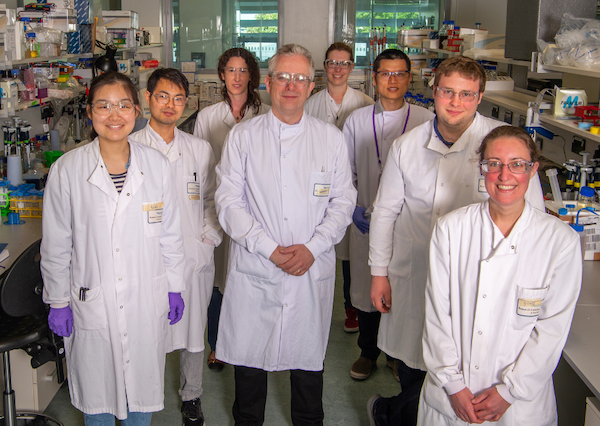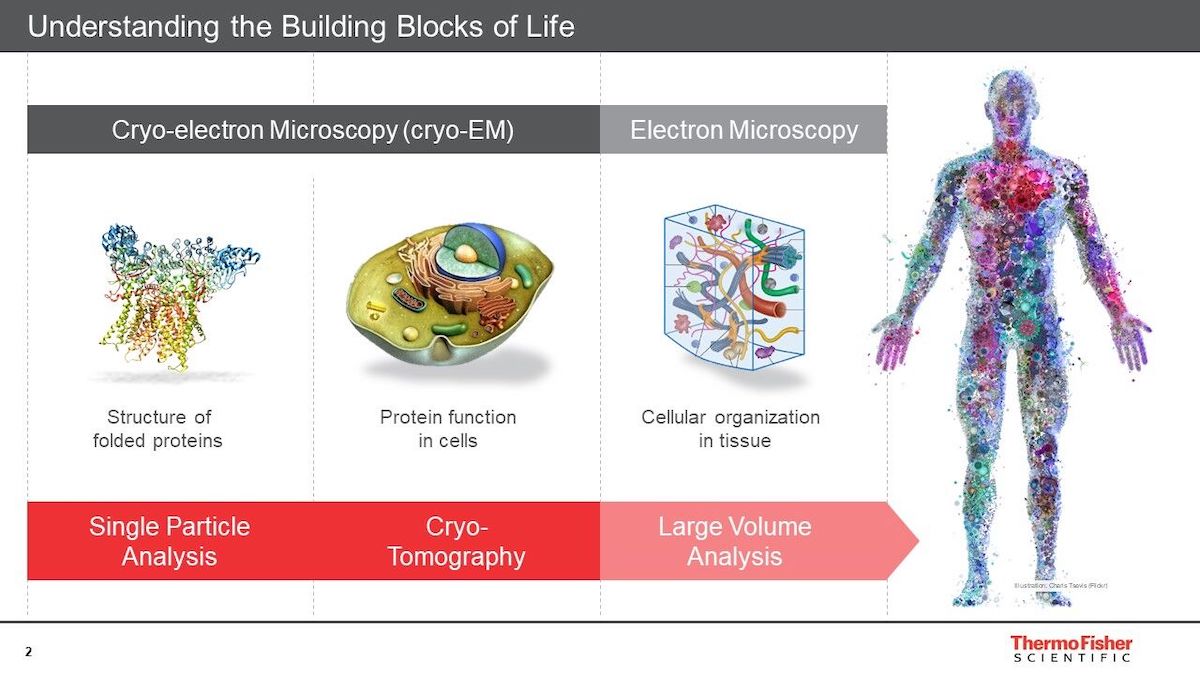Channels
Special Offers & Promotions
New technology to revolutionise drug development
 The search for new drugs to combat diseases more effectively could be revolutionised through a new £30 million electron microscopy project.
The search for new drugs to combat diseases more effectively could be revolutionised through a new £30 million electron microscopy project.
Experts would be able to see, for the first time, how a particular drug works within a patient at a cellular level or the molecular processes set in motion by a genetic mutation.
The technology aims to create 3D images of cells at very high resolution to transform our understanding of diseases such as cancer and revolutionise how new medicines are designed.
The project based at Harwell, in Oxfordshire, will be supported with £3 million from the government’s Office for Life Sciences and led by the global life sciences company Thermo Fisher Scientific and the Rosalind Franklin Institute, which is dedicated to bringing about transformative changes through research and technology development.
 Professor James Naismith, lead researcher and Director of the Rosalind Franklin Institute, said: “Around 80 percent of new drugs fail when they reach clinical trials because we don’t fully understand their effects within a living organism.
Professor James Naismith, lead researcher and Director of the Rosalind Franklin Institute, said: “Around 80 percent of new drugs fail when they reach clinical trials because we don’t fully understand their effects within a living organism.
“We’re currently able to identify genes and proteins that play a role in diseases but can only study these in detail in isolation, not as part of a whole cell or group of cells. This new technology would be the first to allow us to do that, so we can see the full effects of a drug and identify at a much earlier stage what will work and what will not.
“Drug development has never been slower or higher cost than it is now. We need to have a breakthrough in the physical science that supports drug discovery to change that.”
The project is being announced as work begins on the Rosalind Franklin Institute’s central hub building on the Harwell Campus near Oxford. The building will create a specialist environment for sensitive scientific equipment that will be unique in the world. It is set to house 200 researchers and will open in late 2020.
The new imaging technique will be based on a technology called cryogenic electron tomography (cryo-ET), which builds up a 3D image from multiple 2D images of samples which have been flash frozen at temperatures below -180oC.
Although cryo-ET already exists, it can currently only handle small samples, such as parts of cells, and often requires in-house expertise.
Mike Shafer, president of materials and structural analysis at Thermo Fisher Scientific said: “Our company’s mission is to enable our customers to make the world healthier, cleaner and safer, and our collaboration with the Rosalind Franklin Institute, Diamond Light Source and others to develop a more efficient cryo-tomography solution, maps precisely to that vision.
"Our combined goal is to make this technique widespread so scientists and researchers in academic institutions and the biopharmaceutical industry can better understand disease mechanisms at the cellular level, leading to faster drug discovery and cures for neurodegenerative diseases, cancers and other debilitating illnesses.”
The new, five-year research project will rapidly speed up the technique to process much larger samples including patient biopsies, increase workflow automation and standardise post-processing data.
The long-term aim is to bring the technology closer to the clinic so it can be used in both research hospitals and laboratories.
The challenges around the project are formidable. It will require the invention of new techniques for preparing and handling samples of human tissue that are less than a hundredth of the thickness of human hair.
It will involve the design of new electron microscopy techniques to speed up the imaging process and collect the huge amount of data created. New software and machine learning technology will need to be developed to process this data in order to create and interpret the 3D images.
To tackle the challenges, the project brings together an impressive array of expertise from the different research partners. Thermo Fisher Scientific is a global leader in scientific instrumentation; Diamond Light Source, the UK’s national synchrotron facility includes one of the largest industrial cryo-electron microscopy sites in the world; and the Rosalind Franklin Institute, funded through UK Research and Innovation, combines scientific expertise from ten of the UK’s leading universities.
Andrew Bourne, Deputy Director at UKRI’s Engineering and Physical Sciences Research Council (EPSRC), said: “Today we are building for the future of the UK’s research in life sciences and the development of new drugs to benefit us all. This new project is a great example of collaboration between industry, the academic community, and government funding bodies. It is also fantastic to see work beginning on the hub building for the Rosalind Franklin Institute, which has been delivered and managed by UKRI’s Engineering and Physical Sciences Research Council. The Institute’s work will continue the longstanding relationship between research discovery in engineering and the physical sciences and advances in medicine. It will help strengthen the UK’s position in the global research landscape and develop new medical treatments and technologies in the life sciences.”
Prof Peijun Zhang Director of the electron Bio-Imaging Centre (eBIC), the UK’s national cryo-EM centre, and part of Diamond, adds: “eBIC is keen to help push forward this development of in situ biological imaging. We provide existing state of the art instrumentation and expertise to enable cutting edge cell biology science, with access for the UK and worldwide science community using the synchrotron beamline model that changed the face of macromolecular crystallography. We look forward to feeding the new developments through to users as quickly as possible”
The collaboration represents a major investment and is testament to the scientific strengths and long history of the UK in biological imaging and structural biology. The project is part-funded by the Department for Business, Enterprise and Innovation through the Office for Life Sciences as part of the government’s Life Sciences Industrial Strategy.
About Rosalind Franklin Institute
The Rosalind Franklin Institute is a new national institute, funded by the UK government through UK Research and Innovation, dedicated to bringing about transformative changes in life science through interdisciplinary research and technology development. The Institute was formed by UKRI-STFC and ten UK universities: the Universities of Birmingham, Cambridge, Edinburgh, Oxford, Leeds, Manchester and Southampton and Imperial, Kings College and University College London.
About the Engineering and Physical Sciences Research Council (EPSRC)
EPSRC is part of UK Research and Innovation, a non-departmental public body funded by a grant-in-aid from the UK government. EPSRC is the main funding body for engineering and physical sciences research in the UK. By investing in research and postgraduate training, we are building the knowledge and skills base needed to address the scientific and technological challenges facing the nation. Our portfolio covers a vast range of fields from healthcare technologies to structural engineering, manufacturing to mathematics, advanced materials to chemistry. The research we fund has impact across all sectors. It provides a platform for future UK prosperity by contributing to a healthy, connected, resilient, productive nation.
About Diamond Light Source
Diamond Light Source is the UK’s synchrotron science facility. Shaped like a huge ring, it works like a giant microscope, harnessing the power of electrons to produce bright light that scientists can use to study anything from fossils to jet engines to viruses and vaccines. Diamond speeds up electrons to near light speeds, producing a light 10 billion times brighter than the Sun, which is then directed off into 32 laboratories known as ‘beamlines’. At Diamond, scientists can access state-of-the-art Cryo-EM facilities through the Electron Bio-Imaging Centre (eBIC), for both single particle analysis, cryo-tomography and onsite cryo-microscopes - currently being used by scientists to study everything, from complex virus structures, to never before seen proteins. eBIC was established at Diamond following a £15.6 million grant from the Wellcome Trust, the Medical Research Council (MRC) and the Biotechnology and Biological Sciences Research Council (BBSRC). It was the first high-end cryo-electron microscopy (cryo-EM) facility worldwide to be embedded in a synchrotron with user operations set up to mirror the well-established synchrotron beamline model. eBIC is a collaboration between Diamond, Birkbeck College and Oxford University. EBIC's advanced microscopes, detectors and software, allows scientists to investigate and visualise the structure of individual cells and bio-molecules.
Each year thousands of scientists use the UK’s synchrotron and its integrated facilities (eBIC, ePSIC etc.), with 57% visiting and 43% accessing the facility remotely. Diamond’s state-of-the-art facilities and world-class people act as agents of change, addressing 21st century challenges such as disease, clean energy and food security. Diamond research supports new medicines, technologies and advances of all kinds. More than 8,000 papers have been published because of research conducted at the facility. Funded by the UK Government through the Science and Technology Facilities Council (STFC), and by the Wellcome Trust, Diamond is one of the most advanced scientific facilities in the world, and its pioneering capabilities are helping to keep the UK at the forefront of scientific research.
Media Partners



